HBO's Watchmen Episode 7: All The Big References To The Original Comic Book
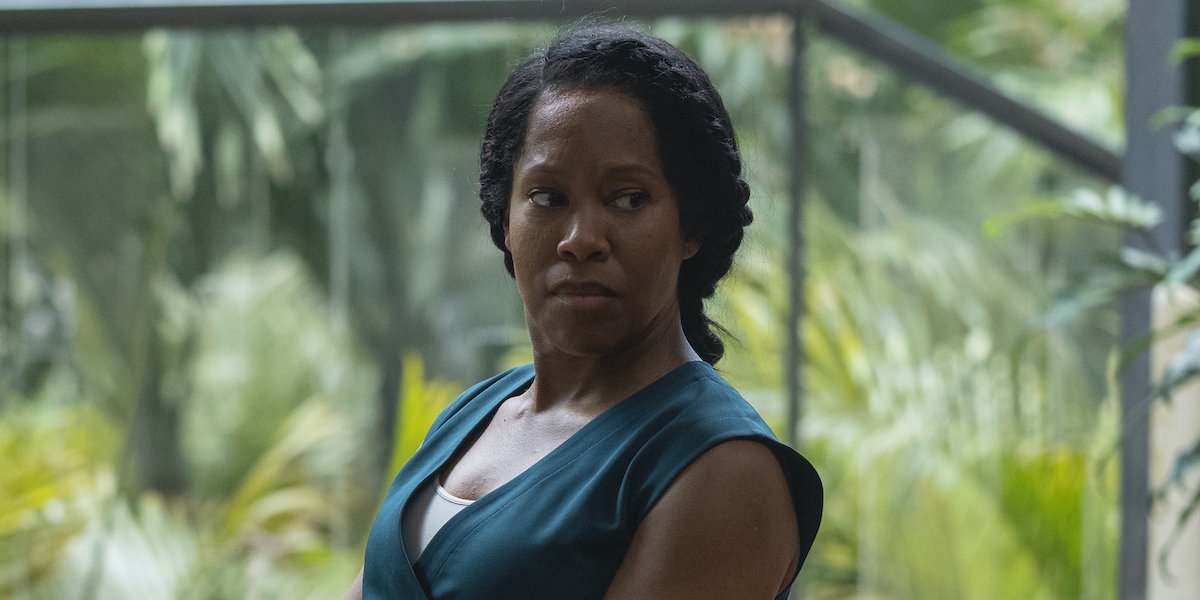
Major spoilers below for the seventh episode of HBO's Watchmen, so be sure and watch before reading on.
For much of its first season, HBO's Watchmen intentionally limited its use of the comic book's most powerful being, Doctor Manhattan. That dam broke with Episode 7, however, which not only gave viewers an assortment of Doctor Manhattan visuals through the years, but also dropped the massive reveal that the super-character has actually been posing as Angela's husband Cal for many years. So many questions, so few episodes left.
While that reveal couldn't have been feasibly set up within Alan Moore and Dave Gibbons' Watchmen, the HBO series definitely kept up with appearances by dropping a slew of comic book-related references with Episode 7, titled "An Almost Religious Awe." From deaths in Vietnam to eccentricities on Europa, Watchmen continued ramping up its unique narrative while paying homage to its roots, and we've rounded up all the biggest comic references in a mostly sequential order.
For those who may have missed out, check out our Watchmen comic references features for Episode 1, Episode 2, Episode 3, Episode 4, Episode 5 and Episode 6.
Dr. Manhattan All Over The Place
As mentioned before, Doctor Manhattan has been purposefully held to a minimum in Watchmen's live-action universe, since his presence would likely overshadow the very important storytelling being done by Damon Lindelof & Co. with the rest of this ensemble. But Angela's Vietnam-set flashback to the day of her parents' deaths gave viewers an idea of just how huge Doctor Manhattan's presence was in the country that became the 51st state of the U.S.A. From dolls to balloons to puppet shows to the poignantly titled documentary Manhattan: An American Life, the superhuman is truly an icon like no other.
This Manhattan-infused opening offers some comic context about the accident that turned physicist Jon Osterman into Doctor Manhattan, complete with an intrinsic field subtractor. This bit also contains a Nova Express "American Cancer" cover, as well as print ads for items fueled by Manhattan's lithium-powered batteries, such as watches (go figure) and cars. Fans also got to see pics of Jon's father Josef's shop, Osterman's Fine Watches in Brooklyn, as well as a pic of the two when Jon was a young boy. Not to mention a sign for Gila Flats, where his life was changed forever.
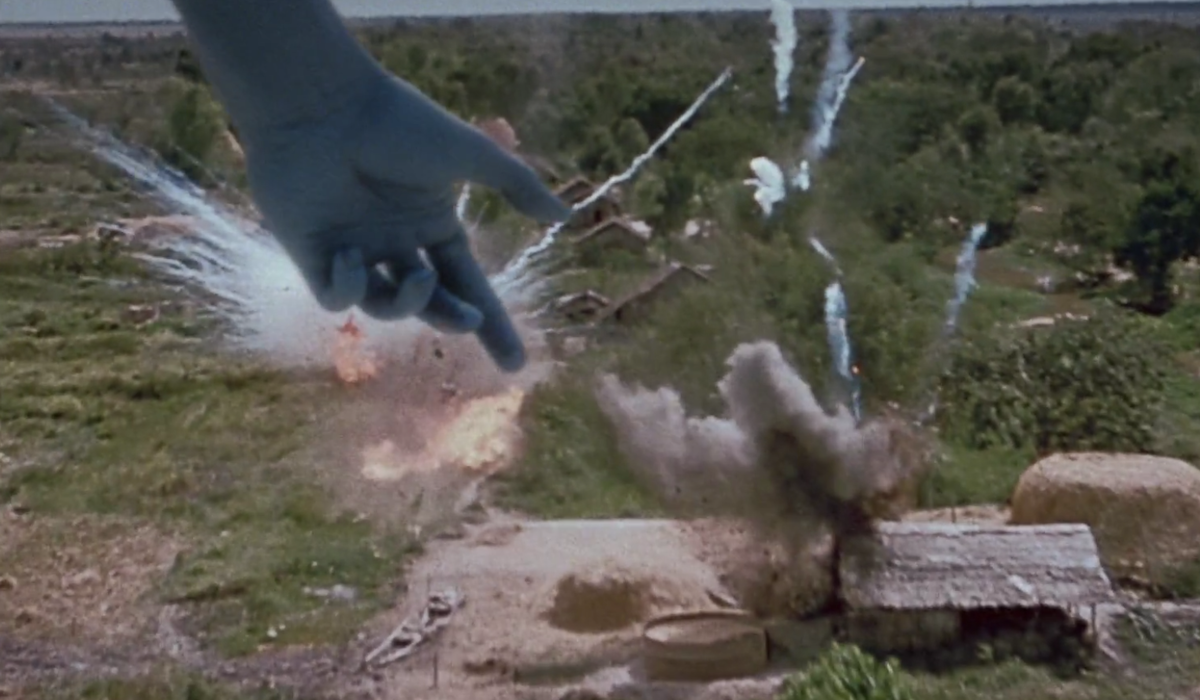
Doctor Manhattan In Vietnam
Even though this moment was part of the faux documentary footage, I would be remiss not to focus on it separately. As Doctor Manhattan's influence over the Vietnam War ending was discussed, the scene shifted to a P.O.V. shot of a gigantic Doctor Manhattan marking his destructive path throughout the tree-filled country. This visual comes directly from the fourth issue of Watchmen, when the character is on Mars and reflecting on his transition and existence, made most evident by his particular hand motion. Note how his face isn't shown in the TV show, however.
Your Daily Blend of Entertainment News
Elephants And Alt-Histories
The Watchmen comic book featured animals in memorable and distinct ways, from the dogs that influenced Rorschach's takeover to the all-important owl. Elephant visuals, in particular, were a common sight as the flying, air-filled promotions for the restaurant Gunga Diner. The Watchmen TV series utilized elephants much more directly, with one being used to flush Nostalgia meds out of Angela's system, no doubt in conjunction with the old adage that an elephant never forgets.
That rather shocking moment was foreshadowed earlier in the episode's video store sequence, in which animated tales showcase pachyderm characters like Trunky and Tusky. It's not exactly clear if their existences are meant as full substitutes for the French creation Babar the Elephant, or if they exist independently.
The Importance Of Titles
For the second episode in a row, Damon Lindelof and his creative team pulled a Watchmen episode title from the source material's text, as opposed to an outside song, poem, etc. In this instance, the title "An Almost Religious Awe" comes from Doctor Manhattan's narration in Issue #4 where his giant form is taking out Vietcong posts. You can read it below.
It’s May. I have been here two months. The Vietcong are expected to surrender within the week. Many have given themselves up already. Often, they ask to surrender to me personally, their terror of me balanced by an almost religious awe. I am reminded of how the Japanese were reported to have viewed the atomic bomb, after Hiroshima.
The implication here is clear enough, even if it's not completely understandable how it all meshes with the TV narrative. If one witnesses a being or event that defies all human logic, then it's likely their fear and distress will be overshadowed by curiosity and wonder. Doctor Manhattan earns that kind of reaction like no other character in this universe.
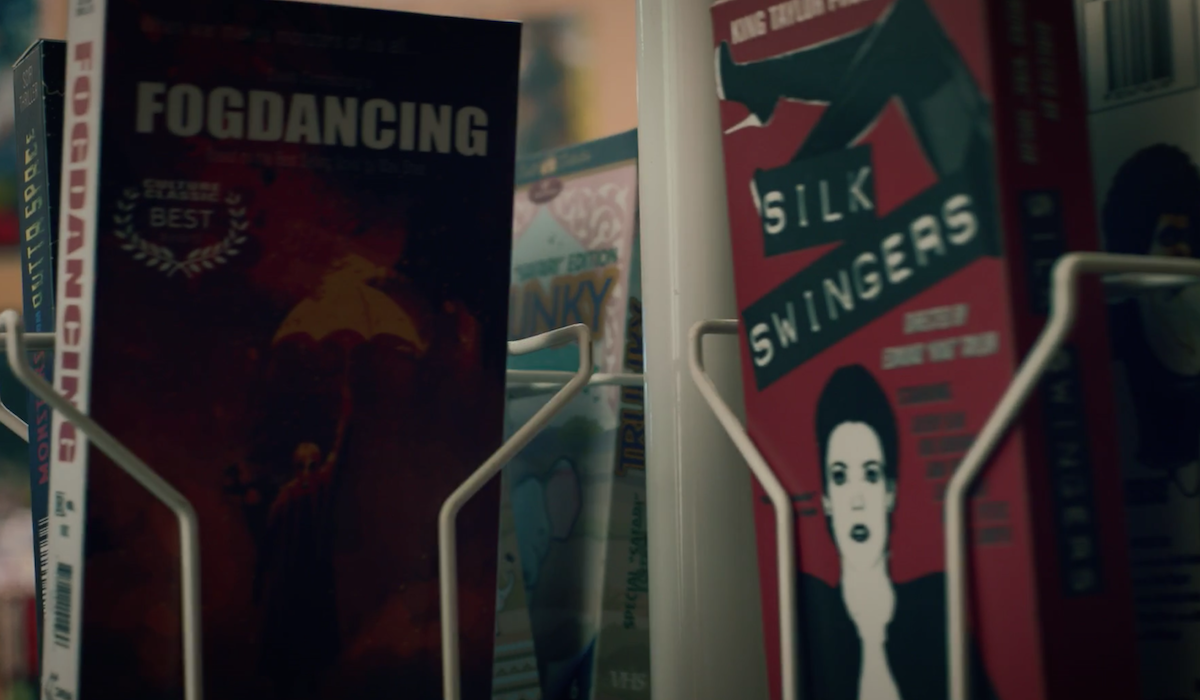
Silk Swingers & Other VHS Movies
As Angela is picking out that extremely influential copy of the (fictional) blaxploitation flick Sister Night, viewers can see several other familiar titles and thematic concepts on the video's rotating rack. Very interesting is the problematic feature Silk Swingers of Suburbia, the Edmund "King" Taylor-directed romp that started its life off as something resembling a more serious biopic. The faux project was referenced within Watchmen's pages as part of Issue #9's supplemental material, with a scathing review thrown in for good measure.
Also on the rack was the cinematic adaptation of Fogdancing, the Max Shea novel that was previously seen being read by a character in Episode 4. Interestingly, the movie was directed by The Fly and Videodrome's David Cronenberg, whose shocking body horror effects call to mind the NYC massacre in both the comic and the TV show.
The more on-the-nose thematic entry was the video for Monsters from Outer Space, a clear reference to the alien squid monster. (It's also worth noting that Ghostbusters still exists in this timeline, and I gotta wonder if that movie references Doctor Manhattan at all.)
Burgers and Borscht
While Gunga Diner was the most used in-world restaurant on Watchmen's pages, the end of the story reveals that the culinary world was affected by even more Eastern European influences after Adrian Veidt's deadly scheme thwarted war plans around the globe. The eatery Burgers and Borscht appeared in a single panel in the Watchmen source material's final issue, in the spot where Gunga Diner was located. In the TV series, it's where Angela meets her grandmother June for their fateful conversation that preceded June's untimely death.
V.V.N. Day
In the Watchmen comic book, V.V.N. Night was meant to be a joyous event celebrating the fact that the U.S. had won the war in Vietnam. It was on that June evening when Doctor Manhattan witnessed (and did nothing to stop) The Comedian point-blank shooting the Vietnamese woman that was clearly pregnant with his lovechild.
A similarly dark moment occurred during the daytime V.V.N. celebration that occurred on the Watchmen TV show. It's where Angela's parents (and others) were murdered by a suicide bomber unhappy with Americans having taken over the country. That sentiment was also expressed in the "Murderer" and blood graffiti added to that Manhattan mural in Saigon.

Triangles
As much as Watchmen has been invested in circular imagery, let's not forget that it was a triangle that connected all the tendrils of Adrian Veidt's conspiracy plots. The triangle was, of course, the symbol for the Veidt-owned Pyramid Deliveries, which funded the Nova Express publication, as well as Dimensional Developments, the company that itself funded the Institute for Extraspatial Studies.
Triangles have appeared in the TV show before, of course, but I found their presence to be particularly noteworthy during the revealing conversation between Laurie Blake and Jane Crawford, in which Jane eagerly confessed she was a part of the scheme cooked up by Joe Keene and the Seventh Cavalry. The couch that Laurie is sitting on has a pillow filled with triangles, while the lampshade seen in the shot with Jane also brings triangular imagery to the scene. Perhaps most important, in terms of villainous hat-tipping? The three-sided case that holds Judd's memorial flag, of course.
Psychological Tests
Upon waking up from one of her Nostalgia naps, Angela was shown a series of images by Lady Trieu's not-actually-her-daughter Bian, who then asked questions involving the card subjects' fears and potential for danger. Bian said it was research for a dissertation surrounding the subject of empathy, which seemed a bit strange until Lady Trieu waved away age-related questions with the reveal that Bian is the clone of Trieu's mother.
Shortly after Walter Kovacs' capture in the Watchmen comic, his sessions began with criminal psychologist Malcolm Long, who initially sought fame from his involvement in Rorschach's case, but quickly showed signs of emotional distress upon hearing the vigilante's stories and criticisms. Their first meeting, which kicks off Issue #5, stars with Mal showing Kovacs a series of Rorschach blots, which the latter bullshits his way through while visualizing his more disturbing true answers. It's obviously not clear if Mal's downward narrative trajectory will be paralleled in Bian in other ways, particularly if she learns of her true nature, but it's worth keeping in mind.
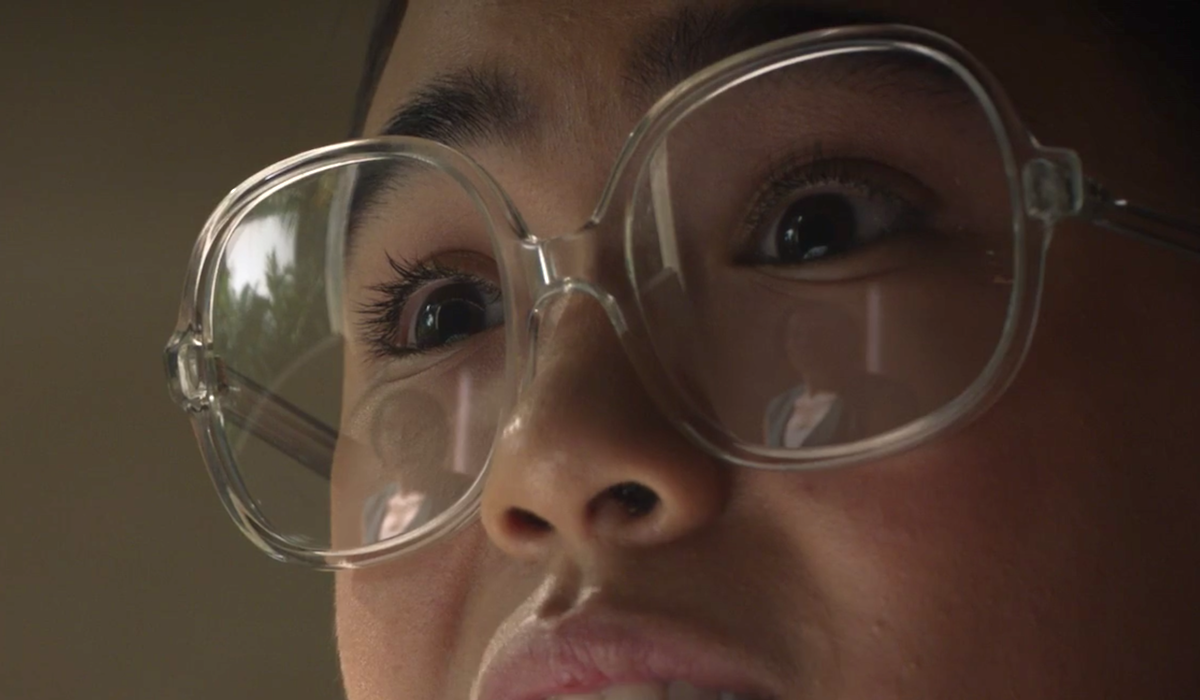
Reflections
In this instance, I'm specifically referring to two Episode 7 scenes that strongly showcased the comic book's penchant for character action being displayed via reflective surfaces. The first was during the aforementioned back-and-forth between Angela and Bian. At certain points, Angela's reactions to Bian's admissions were shown in close-up shots of Bian's eyeglasses, while Angela's eyes offered a smaller reflective surface for the clone to be seen within. It's no coincidence that those glasses are as round and owl-like as they are.
Angela's eyes, which became the stained glass in Veidt's "courtroom" in the episode's most striking scene transition, also played into those game-changing final moments of the episode. After Angela dug the hydrogen atom piece out of Cal's head following his pseudo-death, the all-too-familiar blue glow appeared in full for the first time, and viewers could clearly see Doctor Manhattan's face (and his arm?) reflected in Angel's loving peepers. All in favor of these shots, say eye.
Groaner puns aside, I believe it's thematically relevant for the episode to hold attention on both of Angela's eyes, and possibly Bian's as well, to serve as dual opposition to the one-eyed Cyclops threat that Will sought to vanquish as Hooded Justice. Perhaps it wasn't intentional, but it felt connected enough.
Black Freighter Skull And Crossbones
The familiar pirate-themed imagery from Tales of the Black Freighter returned in Episode 7 within the courtroom setting where Adrian Veidt's 365-day trial took place. It was showcased on the wall behind the Judge, who also goes by Game Warden, further reminding viewers that Veidt's years-long attempts to vacate his moon-based prison serve as Watchmen's TV take on "Marooned," the inter-spliced pirate comic story that flowed through the comic book narrative. We've seen the previous parallels, such as using corpses as a method of escaping, so it will be interesting to see how Damon Lindelof's creative team sticks the landing.
Adrian Veidt's Past Murders
During Veidt's trial, not only were all the 11/2 deaths and moon-clone deaths working against him, but Ms. Crookshanks the Prosecutor also brought up Veidt freely admitting that he "took the lives of fellow costumed adventurers." Clearly, this was another namecheck-avoiding way to bring up The Comedian, whom Veidt murdered after the latter discovered the island where the squid monster was being conceived. (Some viewers likely wondered if Lady Trieu's comment about her father was also in reference to The Comedian, but we'll have to wait and see on that front.)
But was Crookshanks' wording pluralized in a general sense, or was she specifically revealing that Veidt was responsible for killing more than one semi-virtuous vigilante? I suppose someone could lump Moloch into the "costumed adventurers" category if one argued hard enough, but he was still a villain through and through. Perhaps Veidt had a hand in Captain Metropolis' vehicular decapitation. Someone likely did, since the head was apparently never found.
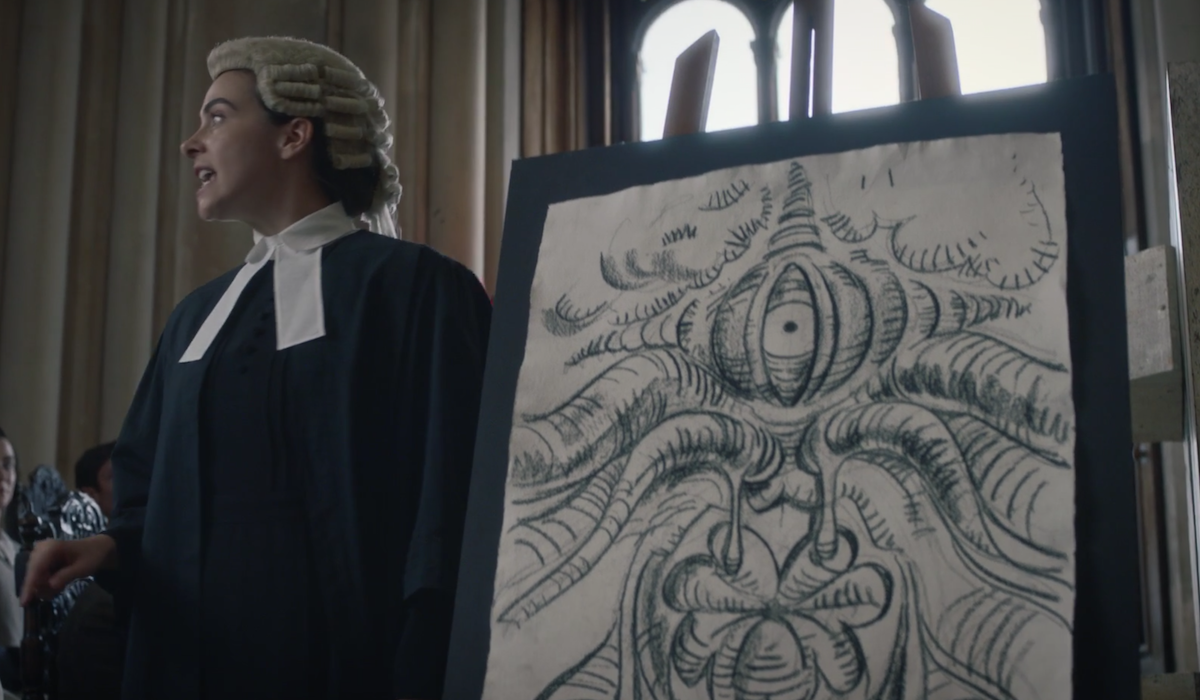
The Original Squid Illustration
With Looking Glass' brain-warping lesson on this universe's lack of squid-related dangers, HBO's Watchmen more or less wrapped up everything that absolutely needed to be said about the creature's influences. However, we not only got another peek of the "squid rain" headline inside Looking Glass' corpse-filled bunker, but Lady Trieu was also serving up some calamari for her big meal before the Millennium Clock goes live.
The biggest callback to the Watchmen comic book, however, came during Adrian Veidt's trial, where Ms. Crookshanks the Prosecutor had a blown-up recreation of the central squid-monster illustration from the great Dave Gibbons. Within the narrative, it was artist Hira Manish who was responsible for crafting the creature's look. She was one of the many who were blown up by Veidt after their mission was completed, and the illustration was last scene washing up on a shore not far from where the group died.
Given the location, though, it's not exactly clear if someone actually discovered the image on Earth and connected Veidt to the boat explosion, or if only the person responsible for Veidt's current imprisonment has access to the picture. It's also not clear if that matters or not.
Butterflies In The Vivarium
In transitioning back from Europa to Earth, Watchmen flipped from Veidt's tear-struck face to the very similar visage of the Ozymandias statue in Lady Trieu's vivarium. From behind the statue flew a butterfly, which carried the camera over to Angela sneaking around. That seemingly non-contextual moment might be strangely foreboding, however, considering the subtly dark butterfly-related moment in the comic.
In the issue where Veidt bloviates about his history and his legacy to his Vietnamese servants, it becomes clear at a certain point that the drinks he'd poured for them were poisoned, and he later opened the vivarium up to allow Antarctica's snow to cover their corpses. The poison's rather instant effect is hinted at by a butterfly sitting on one of the servants' faces for multiple panels, which he surely would have swatted away had he still been alive to notice it. Could the butterfly in Lady Trieu's home be an indication that Veidt actually is already dead in the current timeline?
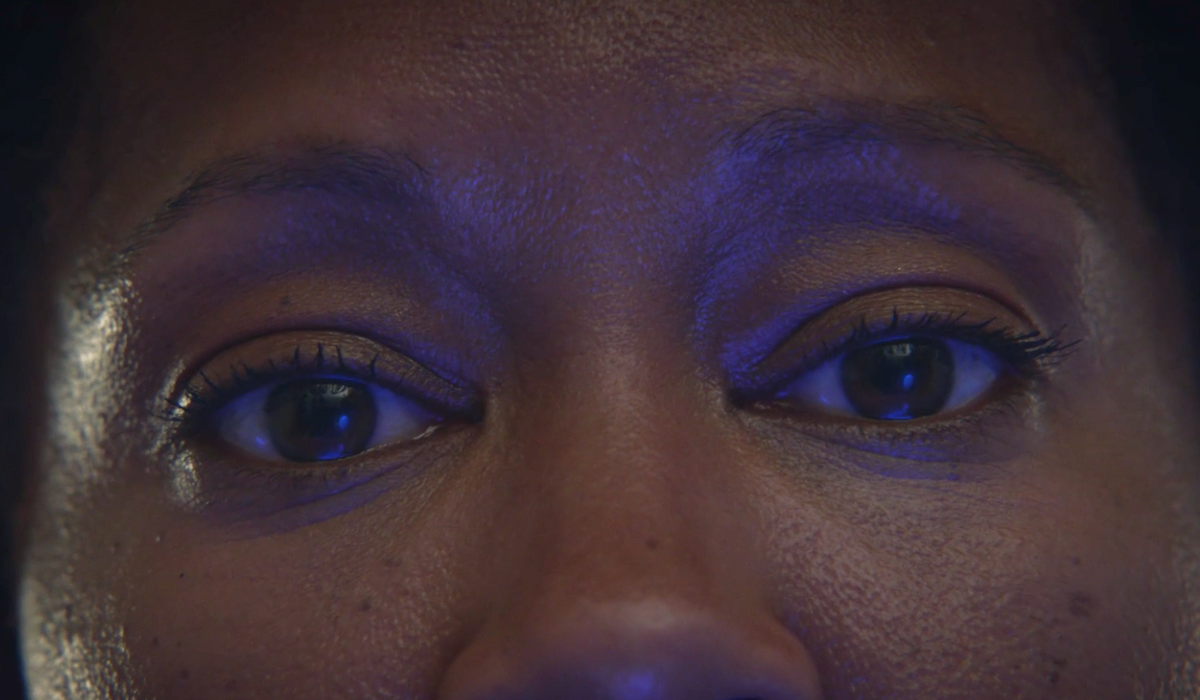
Doctor Manhattan's Return
Beyond everything discussed earlier concerning Doctor Manhattan, the episode's final moments confirm a theory that took hold of a certain section of the fanbase: Cal has actually been Doctor Manhattan this whole time, only with more humanistic feelings cloaking the latent dispassion. While there wasn't a Cal in the comics – we're tiptoeing around the Cal/Kal-El name similarities and the Superman/Doctor Manhattan connections central to the Doomsday Clock arc – one of the last things Doctor Manhattan says hints at the TV show's big reveal. After Veidt brings up the superhuman's rediscovered interest in humans, Doctor Manhattan says:
Yes, I have. I think perhaps I'll create some.
It's obviously easy to also connect that particular line to all of the clone babies that Veidt fishes for on Europa, but in that instance, Doctor Manhattan would have created other beings to witness in a Sims-esque capacity. With Cal, it would appear Manhattan firmly wanted to become a living and breathing human being again, which also falls under the umbrella of "perhaps I'll create some." So many questions left to answer about his relationship with Angela now.
Other Random Thoughts
I like this Manhattan-related ad copy, "The journey should be the last thing on your mind," in the sense of how it applies to Veidt's trials and tribulations.
Did anyone else get vaguely Seinfeld-ian vibes when watching Red Scare eating Cheetos Puffs out of the bag with a fork?
Speaking of other-show vibes, did Watchmen seriously bring up an old Saturday Night Live sketch during Laurie and Jane's scene? In the 1988 SNL episode hosted by Judge Reinhold, there was a fake commercial sketch in which Jon Lovitz's businessman has a series of trapdoor malfunctions. The brand of the trapdoors was Wilson, which was the same brand as Jane's own malfunctioning trapdoor. I suppose that could also be a slight nod to the 2009 film's star Patrick Wilson (who is a fan of the show), but the additional trapdoor stuff is hard to ignore.
Are Jane Crawford and Joe Keene the "two riders" that are approaching to bring about this timeline's judgment day, while Judd was just a semi-racist patsy? I thought it immediately when Jane rode her horse up to Laurie, though I don't think we'll see Joe Keene riding any horses beyond his own high one.
After hearing those highlights from Lady Trieu's life, I want to learn so much more. Especially about that microfusion spacecraft, and how it possibly could have been used to transport someone to Europa.
Where was Angela going to click next on the big Doctor Manhattan call center orb? After hearing Laurie's message from Tulsa, Angela looked as if she has a particular spot in Europe that she was going for, which was interrupted by Lady Trieu's arrival. Is there something more to that moment than meets the eye?
Picking A Penis Body Double Was Just As Awkward As It Sounds For Watchmen Star Tom Mison
With just two episodes left to go in this increasingly incredible first season, Watchmen airs Sunday nights on HBO at 9:00 p.m. ET.
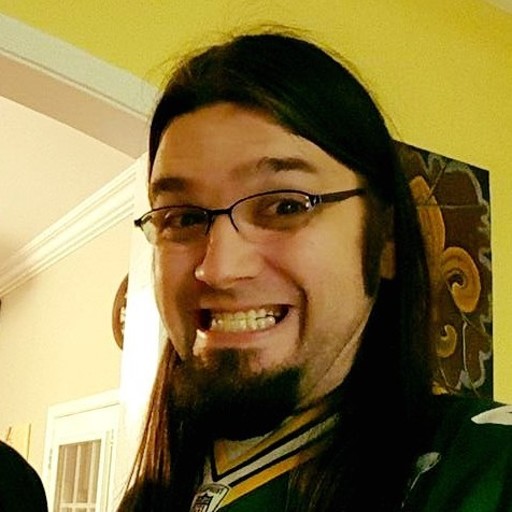
Nick is a Cajun Country native and an Assistant Managing Editor with a focus on TV and features. His humble origin story with CinemaBlend began all the way back in the pre-streaming era, circa 2009, as a freelancing DVD reviewer and TV recapper. Nick leapfrogged over to the small screen to cover more and more television news and interviews, eventually taking over the section for the current era and covering topics like Yellowstone, The Walking Dead and horror. Born in Louisiana and currently living in Texas — Who Dat Nation over America’s Team all day, all night — Nick spent several years in the hospitality industry, and also worked as a 911 operator. If you ever happened to hear his music or read his comics/short stories, you have his sympathy.
